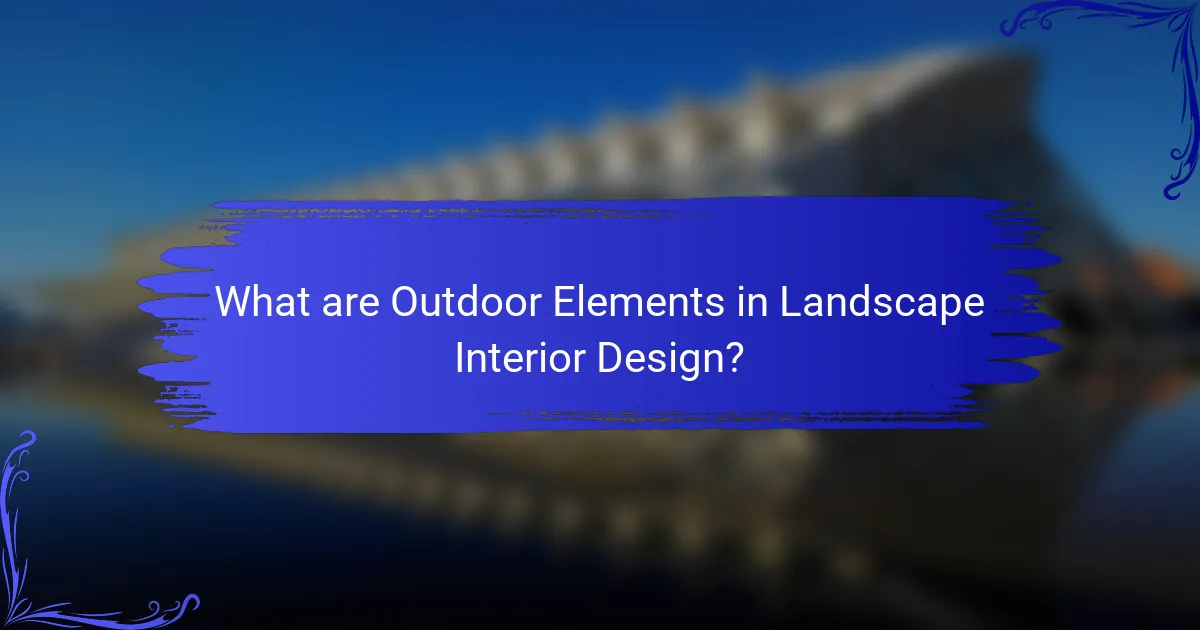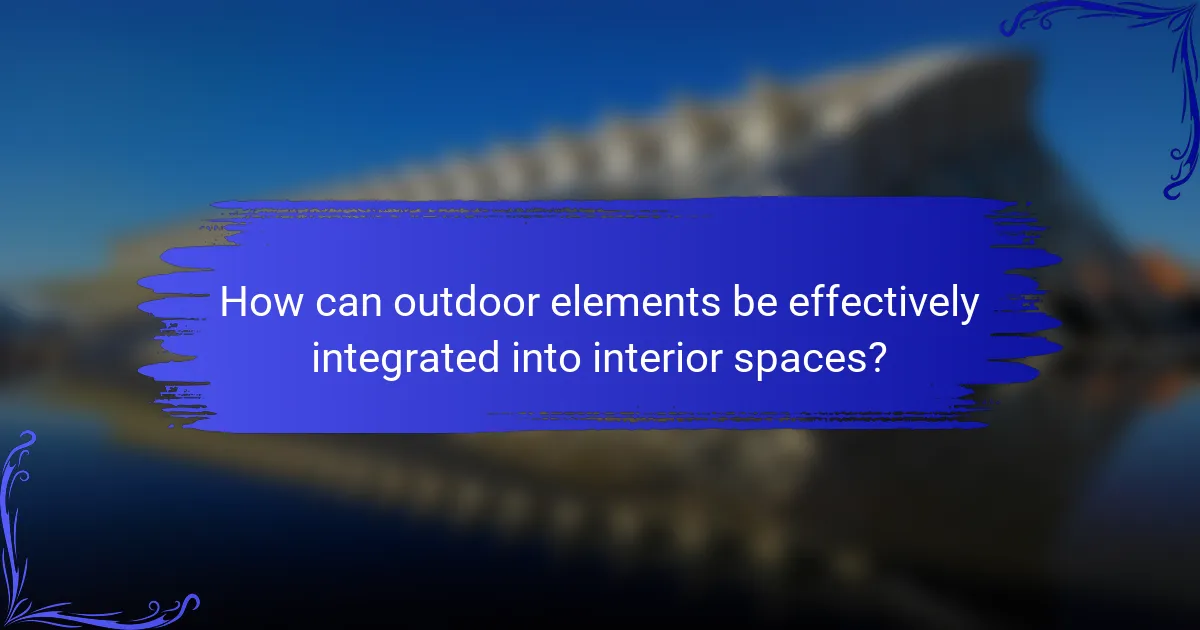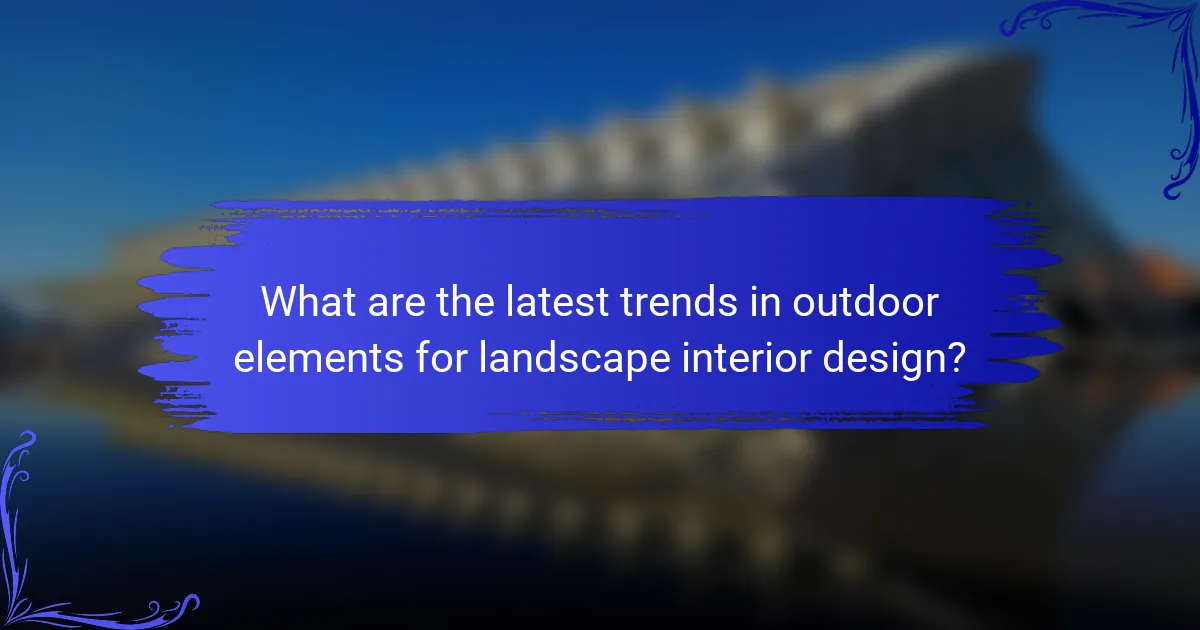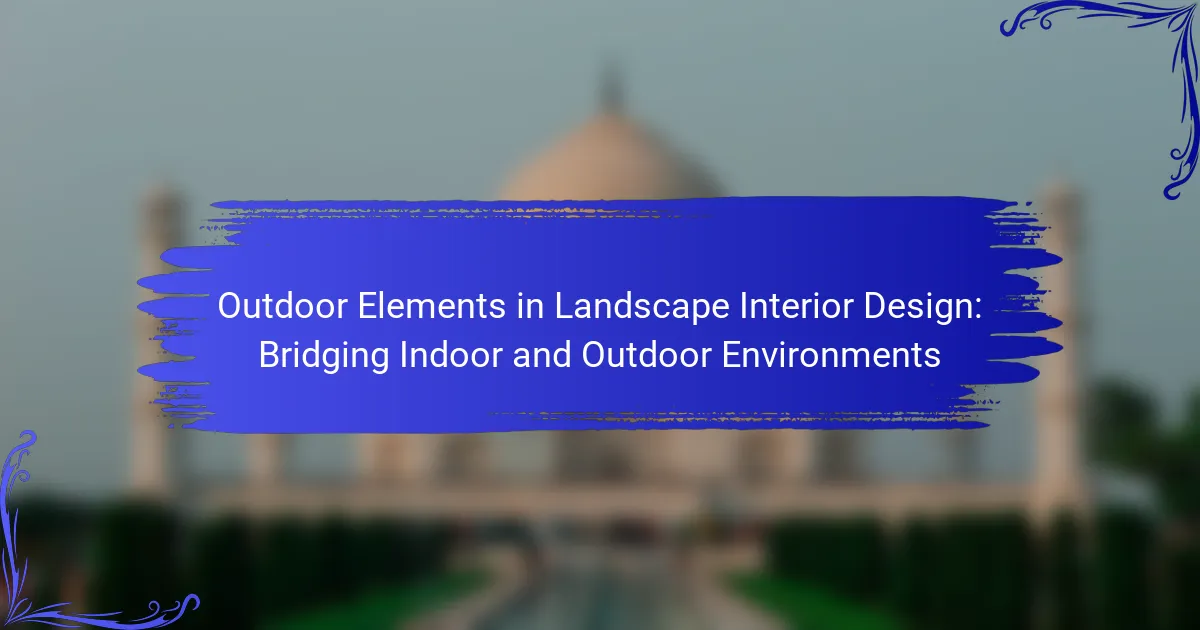Outdoor elements in landscape interior design encompass features that integrate outdoor spaces with indoor environments, including plants, water features, outdoor furniture, and natural materials. This article explores how these elements enhance air quality, tranquility, and aesthetic appeal while promoting well-being through biophilic design principles. Key trends highlighted include the use of sustainable materials, vertical gardens, and smart technology to create seamless transitions between indoor and outdoor living. The integration of natural light and greenery is emphasized as essential for fostering harmony and improving productivity in living spaces.

What are Outdoor Elements in Landscape Interior Design?
Outdoor elements in landscape interior design refer to features that integrate outdoor spaces with indoor environments. These elements include plants, water features, outdoor furniture, and natural materials. Plants can enhance air quality and create a calming atmosphere indoors. Water features, such as fountains or ponds, add tranquility and visual interest. Outdoor furniture provides functional and aesthetic value, allowing for seamless transitions between spaces. Natural materials like stone and wood connect the indoor environment to the outdoor landscape. Incorporating these elements fosters harmony and enhances the overall design.
How do outdoor elements influence indoor environments?
Outdoor elements significantly influence indoor environments through natural light, air quality, and temperature regulation. Natural light enhances mood and productivity by providing psychological benefits. Studies show that spaces with ample daylight can improve focus and reduce stress levels. Air quality is affected by outdoor plants and ventilation, which can introduce fresh air and reduce indoor pollutants. For instance, incorporating indoor plants can improve air quality by filtering toxins. Temperature regulation is influenced by outdoor conditions, as well-designed windows and insulation can help maintain comfortable indoor temperatures. Research indicates that buildings with effective thermal management can reduce energy consumption by up to 30%. Overall, integrating outdoor elements creates healthier and more enjoyable indoor environments.
What specific outdoor elements are commonly used in landscape interior design?
Common outdoor elements used in landscape interior design include plants, water features, and natural materials. Plants such as shrubs, trees, and flowers can enhance indoor spaces by bringing in natural beauty. Water features like fountains or ponds create a calming atmosphere and improve air quality. Natural materials such as stone, wood, and gravel are often incorporated to create a seamless transition between indoors and outdoors. These elements contribute to a cohesive design, promoting a connection with nature. The integration of these outdoor elements can significantly enhance the aesthetic appeal and functionality of interior spaces.
Why is integrating outdoor elements important for design aesthetics?
Integrating outdoor elements is important for design aesthetics because it enhances visual appeal and creates a harmonious environment. Outdoor elements bring natural light and fresh air into spaces, promoting well-being. They also connect indoor and outdoor areas, fostering a sense of continuity. Studies show that incorporating greenery increases mood and productivity by up to 15%. This integration can lead to more inviting and comfortable spaces. Natural materials, such as wood and stone, add texture and warmth, enhancing overall design. Furthermore, outdoor elements can provide seasonal changes, adding dynamic visual interest throughout the year.
What benefits do outdoor elements provide in landscape interior design?
Outdoor elements enhance landscape interior design by creating a seamless connection between indoor and outdoor spaces. They improve aesthetic appeal through natural beauty. Incorporating plants and natural materials adds texture and color. Outdoor elements also promote well-being by reducing stress and enhancing mood. Studies show that exposure to nature can lower blood pressure and improve mental health. Additionally, they increase property value by enhancing curb appeal. Outdoor features like patios and gardens expand usable space. They encourage outdoor activities and social interactions, fostering a sense of community. Overall, outdoor elements significantly enrich landscape interior design.
How do outdoor elements enhance the overall ambiance of a space?
Outdoor elements enhance the overall ambiance of a space by integrating nature into design. They create a sense of tranquility and connection to the environment. Natural light from outdoor elements brightens interiors, improving mood and productivity. Plants and greenery purify the air and contribute to well-being. Textures from outdoor materials add visual interest and warmth. Water features introduce soothing sounds, fostering relaxation. The presence of outdoor views expands perceived space and invites exploration. Research shows that biophilic design, which incorporates outdoor elements, can reduce stress and enhance creativity.
What psychological benefits are associated with incorporating nature indoors?
Incorporating nature indoors offers several psychological benefits. It can reduce stress and anxiety levels. Studies indicate that exposure to natural elements can enhance mood and promote feelings of well-being. For instance, research published in the Journal of Environmental Psychology found that indoor plants can improve concentration and productivity. Furthermore, natural light and greenery can foster creativity and cognitive function. Another study highlighted that views of nature from indoor spaces can lead to quicker recovery from stress. Overall, integrating nature into indoor environments significantly contributes to psychological health.

How can outdoor elements be effectively integrated into interior spaces?
Outdoor elements can be effectively integrated into interior spaces through the use of natural materials, plants, and ample natural light. Incorporating large windows or glass doors creates a seamless connection between indoors and outdoors. Using materials like wood, stone, or bamboo enhances the natural aesthetic. Indoor plants improve air quality and create a calming atmosphere. Water features, such as indoor fountains, add tranquility and visual interest. Natural light can be maximized through skylights and open layouts. These strategies not only enhance the aesthetic appeal but also promote well-being. Studies show that biophilic design, which incorporates nature into indoor spaces, can reduce stress and improve productivity.
What design principles should be considered when blending indoor and outdoor elements?
Design principles for blending indoor and outdoor elements include harmony, continuity, and functionality. Harmony ensures that both spaces complement each other visually. Continuity involves using similar materials and colors to create a seamless transition. Functionality addresses the practical use of spaces, ensuring they serve their intended purposes effectively. Research indicates that spaces designed with these principles enhance user experience and satisfaction. For example, studies show that natural light and views of nature improve well-being. Therefore, applying these principles can lead to more cohesive and enjoyable environments.
How does color selection play a role in the integration process?
Color selection significantly influences the integration process in landscape interior design. It helps create a cohesive visual connection between indoor and outdoor spaces. Color can evoke specific emotions and set the mood of an environment. For instance, greens and earth tones promote tranquility and harmony. Moreover, color can enhance the perception of space and light. Bright colors can make a space feel larger and more inviting. Research shows that color psychology plays a crucial role in user experience and satisfaction. Therefore, thoughtful color choices are essential for successful integration in design.
What materials are most suitable for merging indoor and outdoor environments?
Natural stone, wood, and composite materials are most suitable for merging indoor and outdoor environments. Natural stone offers durability and aesthetic appeal. It can withstand weather variations while providing a seamless look. Wood adds warmth and texture, enhancing the connection between spaces. Treated wood is resistant to moisture and pests, making it ideal for outdoor use. Composite materials combine the best features of wood and plastic. They are low-maintenance and resistant to fading or warping. These materials create a cohesive design that blends indoor comfort with outdoor beauty.
What are common challenges faced when incorporating outdoor elements indoors?
Common challenges faced when incorporating outdoor elements indoors include climate control, maintenance, and integration with indoor design. Climate control is crucial as outdoor elements may not adapt well to indoor temperature and humidity. For example, plants require specific conditions that may not be present indoors. Maintenance can be demanding, as outdoor elements may need regular care and attention that indoor environments typically do not accommodate. Additionally, integrating outdoor elements with existing indoor design can pose aesthetic and functional challenges. This may involve ensuring that materials used are compatible and that the overall design remains cohesive.
How can climate and weather impact the choice of outdoor elements?
Climate and weather significantly influence the selection of outdoor elements. Different climates dictate the types of materials and plants suitable for outdoor spaces. For instance, arid climates require drought-resistant plants and materials that withstand high temperatures. Conversely, humid climates benefit from materials that resist mold and plants that thrive in moisture. Seasonal weather patterns also affect outdoor design choices. In regions with harsh winters, durable materials are essential to withstand snow and ice. Additionally, weather patterns determine the placement of elements like shade structures or windbreaks. Understanding local climate data helps designers make informed decisions. This ensures that outdoor spaces are functional, sustainable, and aesthetically pleasing.
What maintenance considerations should be taken into account?
Maintenance considerations for outdoor elements in landscape interior design include regular inspections, cleaning, and repairs. Regular inspections help identify wear and tear on materials. Cleaning prevents the buildup of dirt and debris on surfaces. Repairs should address any damage to structures or plants promptly. Seasonal maintenance tasks are essential for plant health, such as pruning and mulching. Weatherproofing outdoor elements protects them from harsh conditions. Proper drainage systems prevent water accumulation and damage. Regularly checking for pests ensures plants remain healthy. These considerations enhance the longevity and aesthetic appeal of outdoor elements in design.

What are the latest trends in outdoor elements for landscape interior design?
The latest trends in outdoor elements for landscape interior design focus on integrating nature with living spaces. Biophilic design emphasizes natural light and greenery indoors. Sustainable materials are increasingly popular, promoting eco-friendly practices. Vertical gardens are a trending feature, maximizing space while enhancing aesthetics. Outdoor furniture is being designed for comfort and style, blurring the line between indoor and outdoor living. Smart technology is also being incorporated, allowing for automated outdoor lighting and irrigation systems. These trends reflect a growing desire for harmony between indoor and outdoor environments.
How is sustainability influencing the use of outdoor elements in design?
Sustainability is significantly influencing the use of outdoor elements in design by promoting eco-friendly materials and practices. Designers increasingly prioritize renewable resources like bamboo and reclaimed wood. This shift reduces environmental impact and fosters biodiversity. Sustainable design also incorporates native plants that require less water and maintenance. Additionally, energy-efficient outdoor lighting is becoming standard. These elements enhance aesthetic appeal while minimizing carbon footprints. Research indicates that sustainable landscaping can increase property value by up to 15%. Overall, sustainability drives innovation in outdoor design, aligning aesthetic goals with ecological responsibility.
What innovative materials are being used to replicate outdoor features indoors?
Innovative materials used to replicate outdoor features indoors include synthetic turf, reclaimed wood, and stone veneer. Synthetic turf mimics grass and provides a natural look without maintenance. Reclaimed wood offers an authentic rustic appearance, enhancing warmth and texture in indoor spaces. Stone veneer replicates natural stone, providing durability and aesthetic appeal. These materials have gained popularity due to their sustainability and versatility in design. Their use creates a seamless transition between indoor and outdoor environments, contributing to biophilic design principles.
How are technology and smart design enhancing outdoor element integration?
Technology and smart design enhance outdoor element integration by enabling seamless transitions between indoor and outdoor spaces. Advanced materials allow for weather-resistant furnishings that maintain aesthetic appeal. Smart irrigation systems optimize water usage, promoting sustainability in outdoor landscapes. Automated lighting enhances safety and ambiance, adapting to user preferences. Digital design tools facilitate precise planning and visualization of outdoor elements. Sensors can monitor environmental conditions, ensuring optimal growth for plants. Integration of renewable energy sources supports eco-friendly outdoor features. These innovations collectively create cohesive environments that blend functionality with design.
What practical tips can be applied for successful integration of outdoor elements?
Incorporating outdoor elements successfully requires careful planning and design. Start by assessing the space available for integration. Consider the climate and seasonal changes, as they influence plant selection and material durability. Use natural materials like stone and wood to create a seamless transition between indoor and outdoor areas. Incorporate large windows or sliding doors to enhance visual connectivity. Utilize landscaping that complements the indoor decor, ensuring a cohesive aesthetic. Install outdoor lighting to extend usability and highlight features at night. Finally, choose furniture that is both stylish and weather-resistant for longevity. These strategies enhance the overall experience and functionality of the space.
How can homeowners choose the right outdoor elements for their space?
Homeowners can choose the right outdoor elements by assessing their space and needs. They should consider the size and layout of their outdoor area. Selecting elements that complement the architectural style of their home is crucial. Homeowners should also evaluate their climate and local environment. This ensures the chosen plants and materials will thrive. Budget constraints must be taken into account when selecting features. Researching durable materials can lead to long-lasting choices. Consulting with landscape professionals can provide tailored advice for specific spaces.
What are the best practices for maintaining outdoor elements in indoor settings?
The best practices for maintaining outdoor elements in indoor settings include proper selection, regular care, and environmental control. Selecting suitable plants is crucial. Choose species that thrive indoors, such as snake plants or pothos. Regular care involves watering, pruning, and checking for pests. Indoor plants typically require less water than outdoor ones. Environmental control ensures optimal conditions for growth. Maintain appropriate humidity and light levels. Use grow lights if natural light is insufficient. Additionally, ensure proper drainage to avoid root rot. Following these practices promotes healthy outdoor elements indoors.
Outdoor elements in landscape interior design encompass features that connect indoor spaces with the outdoors, including plants, water features, outdoor furniture, and natural materials. The article explores how these elements influence air quality, natural light, and temperature regulation, enhancing indoor environments. It also discusses common outdoor elements, their aesthetic importance, psychological benefits, and practical integration strategies, while addressing challenges such as climate considerations and maintenance. Additionally, the article highlights current trends and sustainable practices in design, emphasizing the role of technology in creating cohesive indoor-outdoor experiences.
